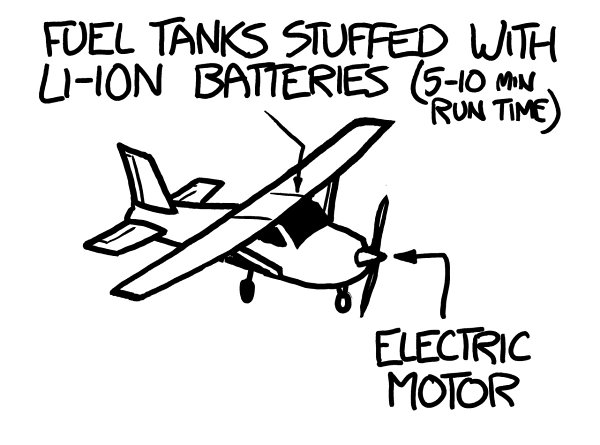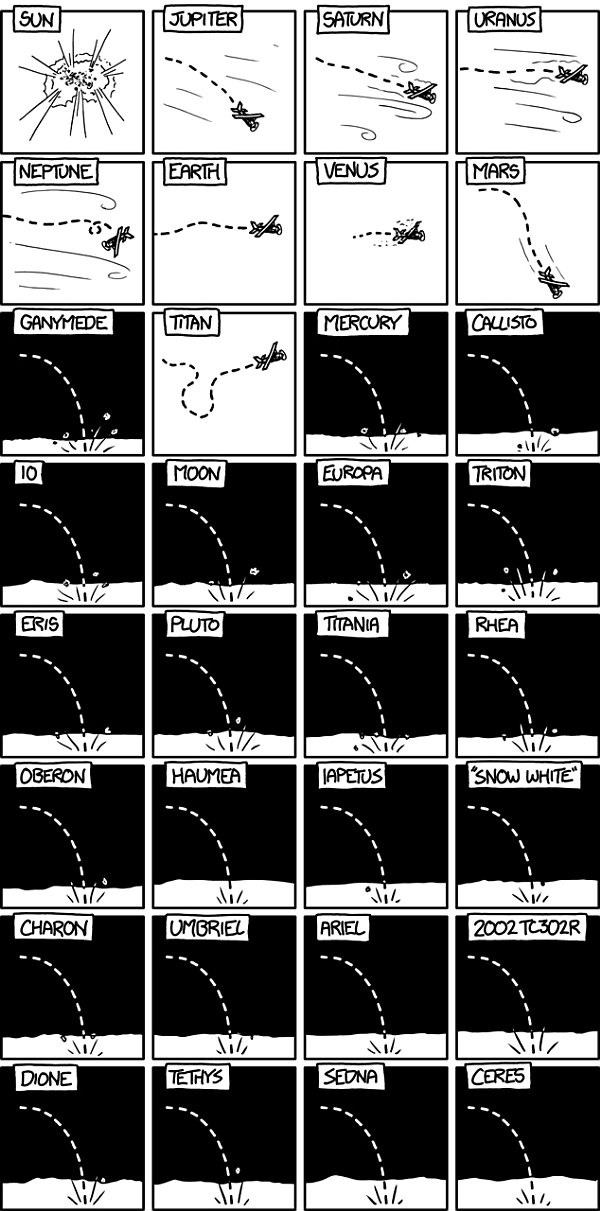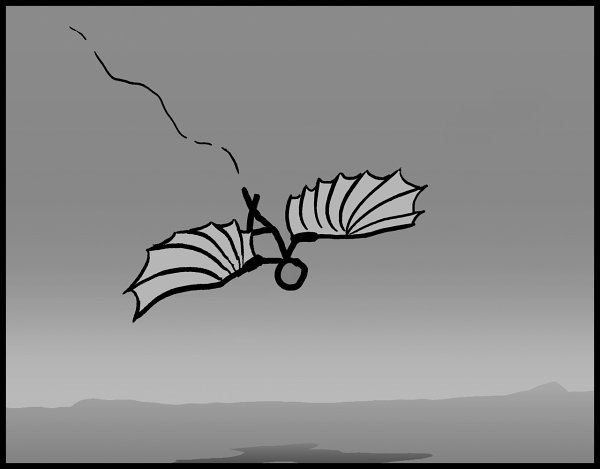What If? (23 page)
Authors: Randall Munroe

Interplanetary Cessna
Q.
What would happen if you tried to fly a normal Earth airplane above different solar system bodies?
—Glen Chiacchieri
A.
Here’s our aircraft:
1

We have to use an electric motor because gas engines work only near green plants. On worlds without plants, oxygen doesn’t stay in the atmosphere
—
it combines with other elements to form things like carbon dioxide and rust. Plants undo this by stripping the oxygen back out and pumping it into the air. Engines need oxygen in the air to run.
2
Here’s our pilot:

Here’s what would happen if our aircraft were launched above the surface of the 32 largest solar system bodies:

In most cases, there’s no atmosphere, and the plane would fall straight to the ground. If it were dropped from 1 kilometer or less, in a few cases the crash would be slow enough that the pilot could survive
—
although the life-support equipment probably wouldn’t.
Th
ere are nine solar system bodies with atmospheres thick enough to matter: Earth
—
obviously
—
Mars, Venus, the four
gas giants, Saturn’s moon Titan, and the Sun. Let’s take a closer look at what would happen to a plane on each one.
Th
e Sun:
Th
is would work about as well as you’d imagine. If the plane were released close enough to the Sun to feel its atmosphere at all, it would be vaporized in less than a second.
Mars:
To see what would happen to our aircraft on Mars, we turn to X-Plane.
X-Plane
is the most advanced flight simulator in the world.
Th
e product of 20 years of obsessive labor by a hardcore aeronautics enthusiast
3
and community of supporters, it actually simulates the flow of air over every piece of an aircraft’s body as it flies.
Th
is makes it a valuable research tool, since it can accurately simulate entirely new aircraft designs
—
and new environments.
In particular,
if you change the X-Plane config file to reduce gravity, thin the atmosphere, and shrink the radius of the planet, it can simulate flight on Mars.
X-Plane tells us that flight on Mars is difficult, but not impossible. NASA knows this, and has considered surveying Mars by airplane.
Th
e tricky thing is that with so little atmosphere, to get any lift, you have to go
fast
. You need to approach
Mach 1 just to get off the ground, and once you get moving, you have so much inertia that it’s hard to change course
—
if you turn, your plane rotates, but keeps moving in the original direction.
Th
e X-Plane author compared piloting Martian aircraft to flying a supersonic ocean liner.
Our Cessna 172 wouldn’t be up to the challenge. If launched from 1 km, it wouldn’t build up enough speed to
pull out of a dive, and would plow into the Martian terrain at over 60 m/s (135 mph). If dropped from 4 or 5 kilometers, it could gain enough speed to pull up into a glide
—
at over half the speed of sound.
Th
e landing would not be survivable.
Venus:
Unfortunately, X-Plane is not capable of simulating the hellish environment near the surface of Venus. But physics calculations give us an idea
of what flight there would be like.
Th
e upshot is: Your plane would fly pretty well, except it would be on fire the whole time, and then it would stop flying, and then stop being a plane.
Th
e atmosphere on Venus is over 60 times denser than Earth’s. It’s thick enough that a Cessna moving at jogging speed would rise into the air. Unfortunately, that air is hot enough to melt lead.
Th
e paint
would start melting off in seconds, the plane’s components would fail rapidly, and the plane would glide gently into the ground as it came apart under the heat stress.
A much better bet would be to fly above the clouds. While Venus’s surface is awful, its upper atmosphere is surprisingly Earthlike. At 55 kilometers, a human could survive with an oxygen mask and a protective wetsuit; the air
is room temperature and the pressure is similar to that on Earth mountains. You would need the wetsuit, though, to protect you from the sulfuric acid.
4
Th
e acid’s no fun, but it turns out the area right above the clouds is a great environment for an airplane, as long as it has no exposed metal to be corroded away by the sulfuric acid. And is capable of flight in constant category-5-hurricane-level
winds, which are another thing I forgot to mention earlier.
Venus is a terrible place.
Jupiter:
Our Cessna wouldn’t be able to fly on Jupiter; the gravity is just too strong.
Th
e power needed to maintain level flight under Jupiter’s gravity is three times greater than that on Earth. Starting from a friendly sea-level pressure, we’d accelerate through the tumbling winds into a 275 m/s (600
mph) downward glide deeper and deeper through the layers of ammonia ice and water ice until we and the aircraft were crushed.
Th
ere’s no surface to hit; Jupiter transitions smoothly from gas to liquid as you sink deeper and deeper.
Saturn:
Th
e picture here is a little friendlier than on Jupiter.
Th
e weaker gravity
—
close to Earth’s, actually
—
and slightly denser (but still thin) atmosphere mean
that we’d be able to struggle along a bit further before we gave in to either the cold or high winds and descended to the same fate as on Jupiter.
Uranus:
Uranus is a strange, uniform bluish orb.
Th
ere are high winds and it’s bitterly cold. It’s the friendliest of the gas giants to our Cessna, and you could probably fly for a little while. But given that it seems to be an almost completely
featureless planet, why would you want to?
Neptune:
If you’re going to fly around one of the ice giants, I would probably recommend Neptune
5
over Uranus. It at least has some clouds to look at before you freeze to death or break apart from the turbulence.
Titan:
We’ve saved the best for last. When it comes to flying, Titan might be better than Earth. Its atmosphere is thick but its gravity
is light, giving it a surface pressure only 50 percent higher than Earth’s with air four times as dense. Its gravity
—
lower than that of the Moon
—
means that flying is easy. Our Cessna could get into the air under pedal power.
In fact, humans on Titan could fly by muscle power. A human in a hang glider could comfortably take off and cruise around powered by oversized swim-flipper boots
—
or even
take off by flapping artificial wings.
Th
e power requirements are minimal
—
it would probably take no more effort than walking.
Th
e downside (there’s always a downside) is the cold. It’s 72 kelvin on Titan, which is about the temperature of liquid nitrogen. Judging from some numbers on heating requirements for light aircraft, I estimate that the cabin of a Cessna on Titan would probably cool
by about 2 degrees per minute.
Th
e batteries would help to keep themselves warm for a little while, but eventually the craft would run out of heat and crash.
Th
e Huygens probe, which descended with batteries nearly drained, taking fascinating pictures as it fell, succumbed to the cold after only a few hours on the surface. It had enough time to send back a single photo after landing
—
the only
one we have from the surface of a body beyond Mars.
If humans put on artificial wings to fly, we might become Titanian versions of the Icarus story
—
our wings could freeze, fall apart, and send us tumbling to our deaths.

But I’ve never seen the Icarus story as a lesson about the limitations of humans. I see it as a lesson about the limitations of wax as an adhesive.
Th
e cold of Titan is just an engineering problem. With the right refitting, and the right heat sources, a Cessna 172 could fly on Titan
—
and so could we.
weird (and worrying) questions from the what if? INBOX, #6

Q
. What is the total nutritional value (calories, fat, vitamins, minerals, etc.) of the average human body?
—Justin Risner

Q.
What temperature would a chainsaw (or other cutting implement) need to be at to instantly cauterize any injuries inflicted with it?
—Sylvia Gallagher

